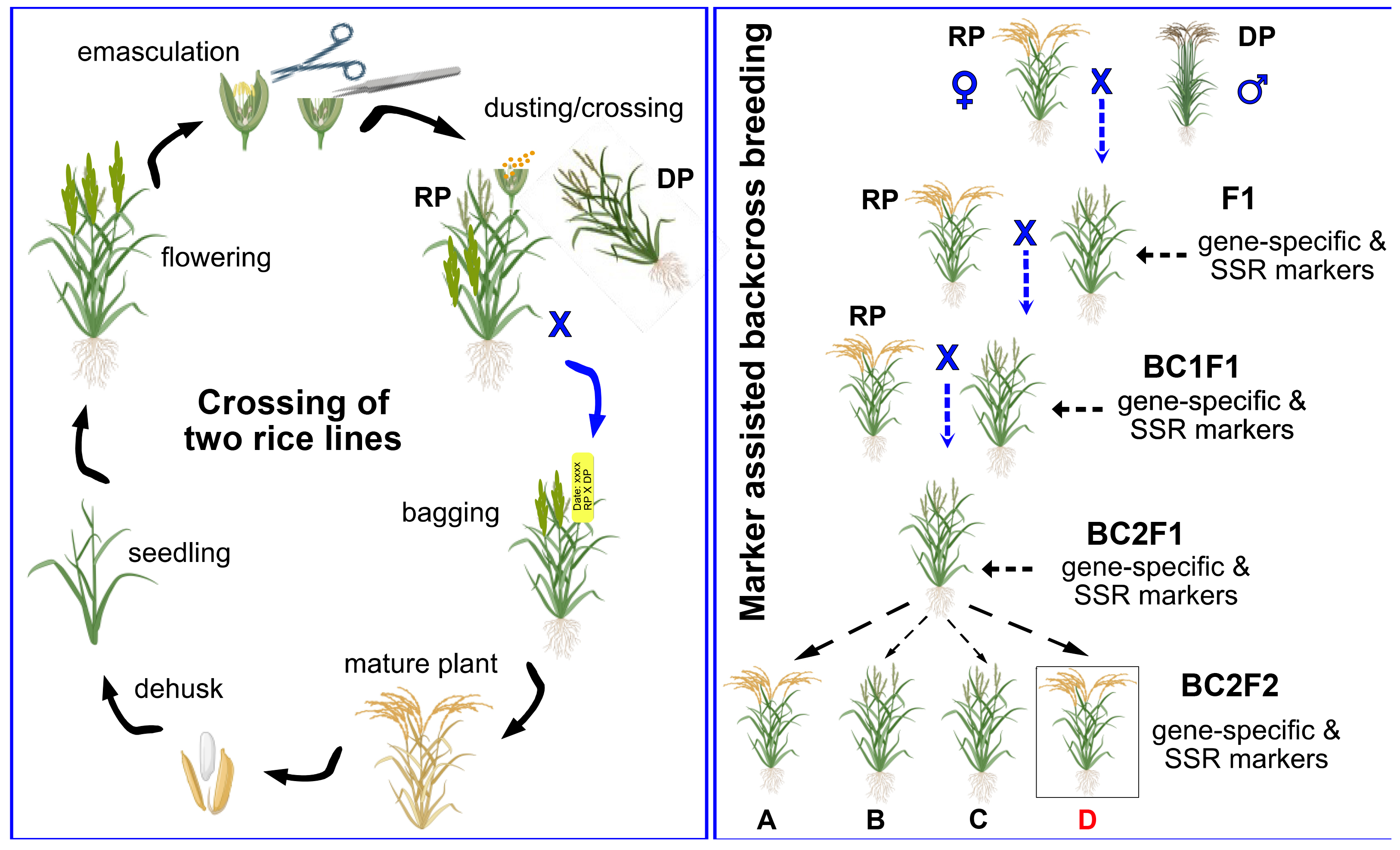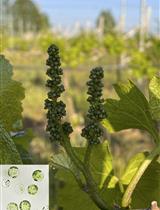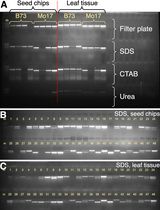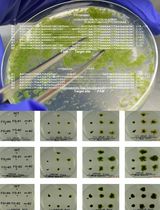- EN - English
- CN - 中文
A Step-by-step Protocol for Crossing and Marker-Assisted Breeding of Asian and African Rice Varieties
亚洲和非洲水稻品种杂交与标记辅助育种逐步指南
发布: 2024年09月20日第14卷第18期 DOI: 10.21769/BioProtoc.5069 浏览次数: 2121
评审: Samik BhattacharyaWenrong He
Abstract
Improving desirable traits of popular rice varieties is of particular importance for small-scale food producers. Breeding is considered the most ecological and economic approach to improve yield, especially in the context of pest and pathogen-resistant varieties development. Being able to cross rice lines is also a critical step when using current transgene-based genome editing technologies, e.g., to remove transgenes. Moreover, rice breeders have developed accelerated breeding methods, including marker-assisted backcross breeding (MABB) to develop novel rice varieties with in-built resistance to biotic and abiotic stressors, grain, and nutritional quality. MABB is a highly efficient and cost-effective approach in accelerating the improvement of recipient variety by introgressing desirable traits, especially from landrace cultivars and wild rice accessions. Here, we provide a detailed protocol including video instructions for rice crossing and MABB to introgress target trait(s) of interest into the elite rice line. Further, we also highlight tips and tricks to be considered for a successful crossing and MABB.
Key features
• This protocol provides detailed information on techniques for crossing rice varieties and for breeding rice varieties with new traits
• The protocol includes instructions for making rice crosses as well as MABB
• The protocol provides beginners with detailed instructions including troubleshooting guides
Keywords: Rice (水稻)Graphical overview

Illustration of crosses of rice lines and marker-assisted backcross breeding (created with BioRender.com)
Background
Rice is one of the most important food staples for over 3.5 billion people. Classical breeding enables the development of new varieties by trait introgression for important agronomic characters and increased tolerance/resistance to abiotic/biotic stressors. Backcross breeding uses donor and recipient parents (DP and RP, respectively); the DP carries the desired traits to be introgressed into an RP, typically an elite variety. Classical breeding inadvertently introduces undesirable traits from the donor and/or the loss of beneficial RP traits. It is, therefore, necessary to backcross the resulting progeny, i.e., the F1 generation, multiple times with the RP to eliminate as much of the chromosomal segments from the DP that do not carry the trait of interest as possible. Crossovers close to trait gene loci are desirable to eliminate the chance that linked loci adversely impact the resulting variety's performance.
Developing a new rice variety through breeding takes 7–8 years (two seasons per year, maximum of 16 seasons of cultivation) [1]. New varieties must be tested in multilocation field trials to validate trait improvements relative to parental lines before new varieties are registered, which takes another two years. Marker-assisted backcross breeding (MABB) reduces this timeline to three years and reduces linkage drag from the DP [1]. MABB introgresses loci encoding desired traits into the RP and reconstitutes the genome of RP by background selection, eliminating undesirable genomic fragments, i.e., linkage drag, from the DP. MABB uses gene-based/gene-linked molecular markers for foreground; to select the desired trait/loci from DP, it uses background selection (to determine the percentage recovery of RP genome) and recombinant selection (to determine the presence of linkage drag) [2,3]. The success of MABB depends on, among other things, differentiating the genome of DP from the genome of RP. Typically, simple sequence repeat (SSR) markers are used as polymorphic molecular markers for differentiating genomic backgrounds [4]. SSR markers are short DNA motifs (2–6 nucleotide repeats) that exhibit variable repeat numbers in the genome. SSRs are abundant, multi-allelic, co-dominant, hypervariable, and relatively uniformly distributed in the genome. SSR markers have become important and widely used in rice breeding [2,5,6].
Apart from its application in plant breeding, crosses are an essential step for eliminating transgenes introduced via genome editing. Genome editing offers the potential to target multiple loci for providing broad-spectrum resistance, nutritional fortification, and yield improvement in crops [7–10]. Notably, the term new breeding methods, frequently used in the context of genome editing, is not an optimal choice, since it is rather an alternative for generating genetic variation, in particular targeted modifications compared with the use of naturally occurring mutations or chemical- or radiation-induced mutagenesis; the breeding process, on the other hand, remains in the hands of breeders and requires their technologies and experience. In countries with appropriate regulations, genome-edited crops are treated as equivalent to crops generated by classical breeding [11].
Materials and reagents
Biological material
Two rice parents, DP and RP, to develop new desirable rice varieties.
Choice of DP
Reproductive isolation can limit the ability to cross diverse rice varieties or landraces [12,13]. Incompatibility between DP and RP crossing leads to sterility in subsequent crosses [14]. Therefore, choose a DP genetically compatible with the RP that produces fertile F1 seeds after the cross. In rice, crosses involving indica and japonica subspecies often produce sterile seeds. Similarly, crosses between Oryza sativa spp. indica (RP) and the DP from a wild rice species/Oryza glaberrima are reported to show embryo abortion/sterility; for example, Komboka (accession: IR05N221) (RP), and FARO 44 (accession: WAB0004879) (DP).
The DP should possess at least a few characters of distinctness, uniformity, and stability (DUS) to the RP. DUS characters play a key role during varietal nomination and evaluation [15]. MABB-derived lines with at least 1–2 DUS characters to the RP are desirable. The choice and variety of releases also depend on DUS characters.
Choose a DP that provides a novel resource for pest/disease resistance, stress tolerance, yield attributes, agronomic characters, or grain quality.
In most cases, DP is either a landrace or a wild accession. Note that it is challenging to make a successful cross between some rice species due to crossing barriers (e.g., Oryza sativa and Oryza glaberrima).
Choice of RP
Choose an elite RP that possesses desirable characteristics including plant phenotype, protection against biotic/abiotic factors, or utilization traits (grain and cooking quality attributes).
The improved RP with higher gain yield and better economic returns tends to have higher acceptance among large-scale farmers.
Murashige and Skoog basal salt mixture (Duchefa, catalog number: M0254)
Sucrose (Sigma-Aldrich, catalog number: S0389)
Phytagel (Sigma-Aldrich, catalog number: P8169)
peqGOLD Plant DNA Mini Kit (VWR, catalog number: 13-3486-02)
GoTaq G2 Green Master Mix (Promega, catalog number: M7823)
Agarose (Sigma-Aldrich, catalog number: A6013)
GeneRuler 1 kb Plus DNA Ladder, ready to use (Thermo Scientific, catalog number: SM1334)
Equipment
Analytical and precision balances (Precisa Gravimetrics AG, Series 321LS, model: LS 2200C)
Laboratory reagent bottles with screw cap, 1,000 mL (Duran®, catalog number: 218015455)
Benchtop pH meter, WTWTM inolab TM 7110 (Fisher Scientific, catalog number: 11731381)
Magnetic stirring bars, cylindrical 25 × 8 mm (VWR, catalog number: 442-0483)
Autoclave (Systec, model: 3850 EL)
Sterile workbench (Thermo Scientific, model: HeraguardTM Eco)
Petri dishes (Sigma-Aldrich, catalog number: P5606-400EA)
Tissue culture vessel, MagentaTM GA-7 (VWR, catalog number: SAFSV8505-100EA)
Hand-held wooden cereal dehusker
Centrifuge tubes with screw cap, 15 mL (Thermo Scientific, catalog number: 339650)
Permanent marker pen
Precision tweezers (VWR, catalog number: 232-1220)
Precision forceps, extra sharp, curved (VWR, catalog number: BOCH1940)
Growth chamber with 27 °C, 16/8 h day/night photoperiod (Percival, model: CU-41L5)
Head-band magnifying glasses (may be advantageous for proper emasculation)
Seed paper bag (11.5 × 6 cm)
Retro floor lamp with E27 Bulb including 3 lights tree floor lamp
Plastic pots, 11 × 11 × 12 cm (Mayer shop, catalog number: 722009)
Plastic tray to keep plastic pots, 50 × 32 × 6 cm (Mayer shop, catalog number: 749112)
Whatman filter paper (VWR, catalog number: 516-0593)
Height adjustable stool, useful during emasculation
Spray bottle for water, 1000 mL (Roth, model: IC8T.1)
Nanodrop (Thermo Fisher, catalog number: 13-400-519)
Thermocycler (Bio-Rad, model: T100TM, catalog number:1861096)
EasyPhor Medi gel electrophoresis system 3GT 15 × 10 cm (Biozym, catalog number: 615162)
Gel documentation unit (Vilber, model: E-BOX CX5 TS)
Drying and heating cabinets with mechanical adjustment (Binder, catalog number: E28)
DanKlorix® original (2.8 g/100 mL sodium hypochlorite)
Procedure
文章信息
稿件历史记录
提交日期: Apr 9, 2024
接收日期: Jul 10, 2024
在线发布日期: Aug 26, 2024
出版日期: Sep 20, 2024
版权信息
© 2024 The Author(s); This is an open access article under the CC BY-NC license (https://creativecommons.org/licenses/by-nc/4.0/).
如何引用
Arra, Y., Loo, E. P., Devanna, B., Stiebner, M. and Frommer, W. B. (2024). A Step-by-step Protocol for Crossing and Marker-Assisted Breeding of Asian and African Rice Varieties. Bio-protocol 14(18): e5069. DOI: 10.21769/BioProtoc.5069.
分类
植物科学 > 植物育种
植物科学 > 植物分子生物学 > 遗传分析
生物科学 > 生物技术
您对这篇实验方法有问题吗?
在此处发布您的问题,我们将邀请本文作者来回答。同时,我们会将您的问题发布到Bio-protocol Exchange,以便寻求社区成员的帮助。
提问指南
+ 问题描述
写下详细的问题描述,包括所有有助于他人回答您问题的信息(例如实验过程、条件和相关图像等)。
Share
Bluesky
X
Copy link













